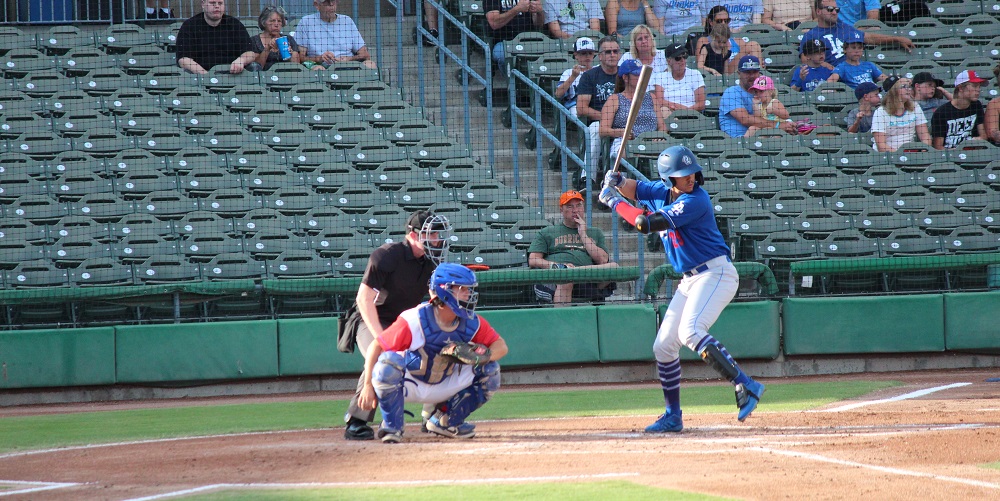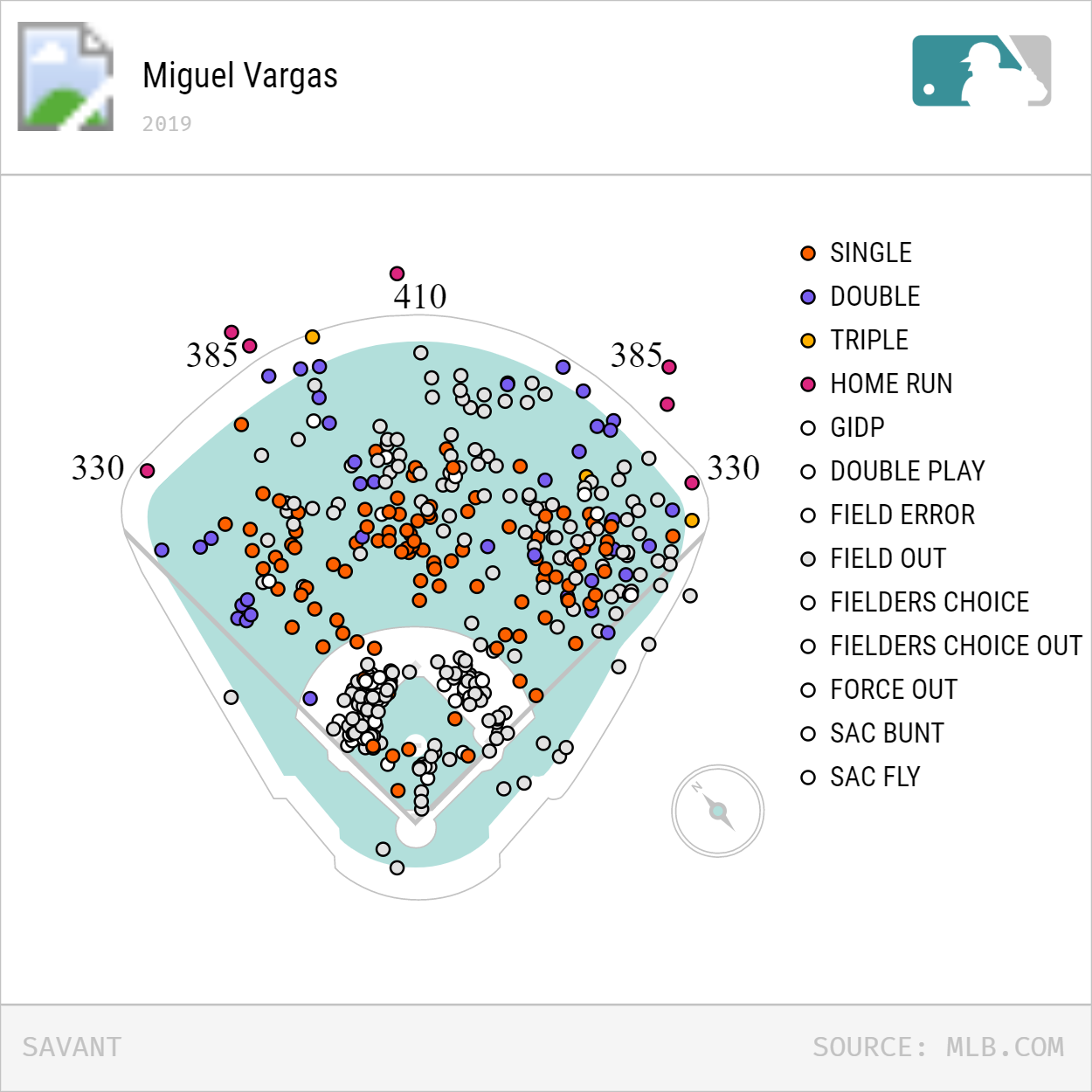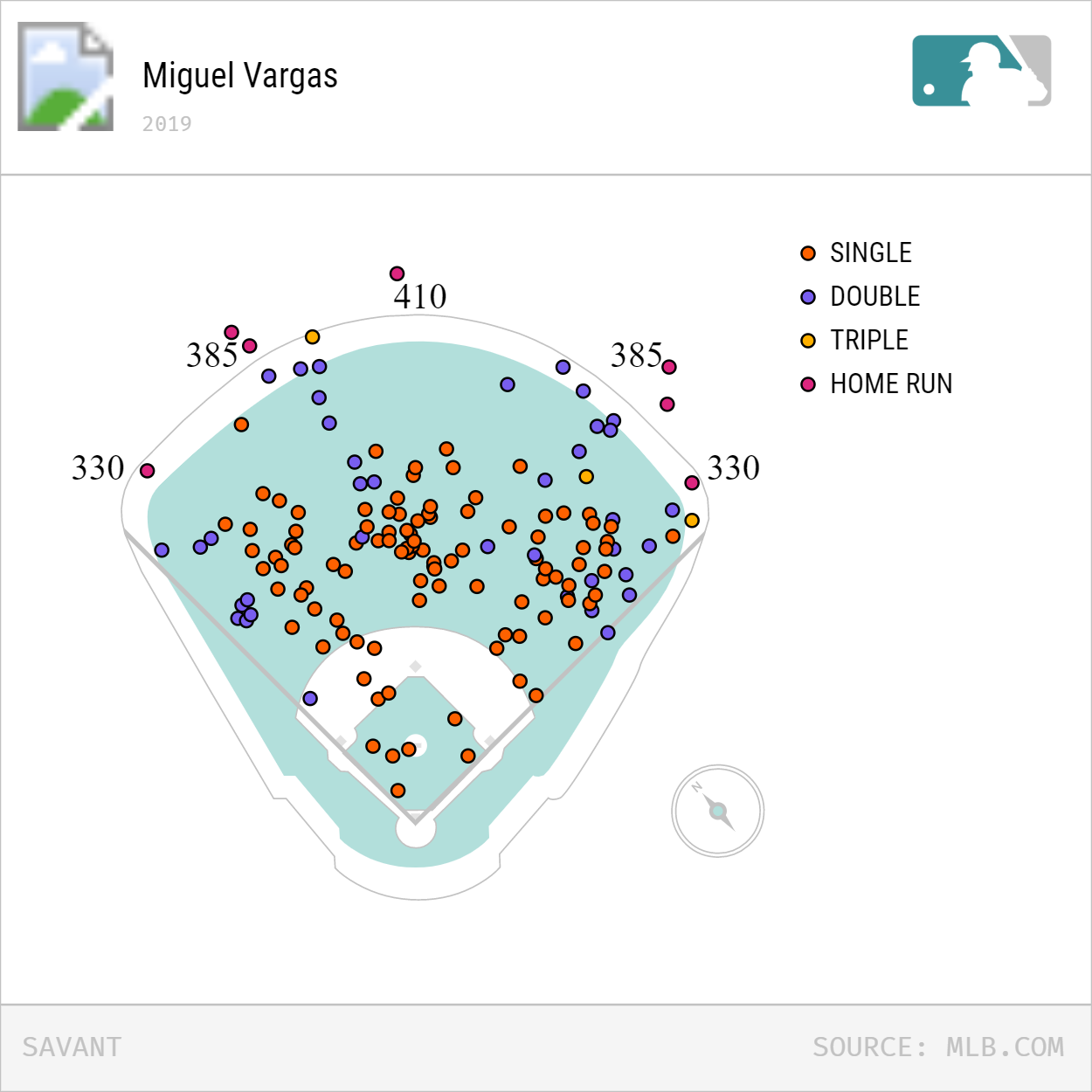Now it’s getting real. We’ve reached the Top 5 of the Dodgers Top 100 prospects countdown. Miguel Vargas is up, and he could be at or near the top of the system this time next year.
——
Previous Entries
- Introduction
- 100-51
- 50-41
- 40-31
- 30-21
- 20-11
- No. 10 – Michael Busch
- No. 9 – Kody Hoese
- No. 8 – Diego Cartaya
- No. 7 – Brusdar Graterol
- No. 6 – Keibert Ruiz
——
I’ve included Future Value (FV) grades and risks for the Top 50 prospects. For example, if a guy gets a “50 low,” he has a really good chance to be an average player at his position. If a guy gets a “55/High,” there’s a good chance he won’t reach that ceiling, but the potential is there. The grades are 20-80 (50 is average), and the risks are as follows:
- Low: Players who are usually older, have debuted, are relievers and/or have higher floors than ceilings
- Medium: Players who are a mix of younger and older, usually have higher floors
- High: Players who are usually younger with potential, but also question marks
- Extreme: Players who are generally younger with star potential, but a ton of question marks
This is to show what value a player might provide at the MLB level. The higher the risk, the less likely a player will reach that ceiling.
——
Editor’s Note: I am not a scout (#notascout). I am an amateur when it comes to evaluating players. I don’t claim to be a pro, I just want to pass along the information I observe/obtain to the people. Notes and comments are based on personal observation, talking to sources, reading scouting reports and watching video. For future entries in this series: All ratings in the charts below are on the standard 20-80 scouting scale, where 50 is roughly average, 80 is elite and nearly unattainable and 20 is unacceptably poor. Enjoy.
Other Notes: “Role” is a realistic future role (slightly optimistic in some cases). Age is the 2020 season age for the player (June 30 is the cutoff date).
——
Rating Key
| 80 — Elite |
| 75 — Borderline Elite |
| 70 — Plus-plus |
| 60-65 — Plus |
| 55 — Above-average |
| 50 — Average |
| 45 — Fringe-average |
| 40 — Below-average |
| 30-35 — Poor |
| 20-25 — Very Poor |
5. Miguel Vargas
| DOB: 11/17/99 | Age: 20 | Height: 6’3 | Weight: 205 | Bats: Right | Throws: Right | Position: 3B |
Acquired: International free agent (Cuba), September 2017, $300,000 signing bonus
Physical description: Strong core, projectable frame
Strengths: Great bat-to-ball, opposite field approach, strong arm
Weaknesses: Present power lacking, could outgrow 3B
Key statistics: .308/.380/.440, 9.8 BB%, 14.8 K%, .132 ISO (A/A+)
Role: First-division third baseman
Player comparison: Very poor man’s Miguel Cabrera
Summary: Vargas defected from Cuba and was a bit of an under-the-radar signing by the Dodgers in 2017, when they were limited to signing no single player for more than $300,000. They’ve had some infamous misses (especially in the Cuban market) of late, but Vargas could end up being a huge win. Through his age-19 season, he has shown the mature approach seen in prospects who have been playing pro ball for 3-4 years and are 2-3 years older than Vargas. He got off to a slow start — as most prospects do in the Midwest League — but he rebounded to make the MWL All-Star Game and post a nearly .400 OBP with the Loons before heading to Rancho Cucamonga. His numbers weren’t as strong with the Quakes, but he did see two important increases in his batted ball profile: He hit more fly balls (up almost 4 points) and hit pulled the ball more frequently (up 3.5 points). This bodes well for the young slugger going forward.
Vargas’ best tool is his potentially plus-hit tool. He doesn’t have Ruiz-level hand-eye coordination, but it isn’t far off. He doesn’t normally chase pitches out of the strike zone and has good pitch recognition. Right now, he has more gap power than over-the-fence power, but he has the frame to add some good weight and turn some of those line drives to the gaps into fly balls over the wall. What’s most impressive about him is his ability to go to the opposite field. He’s not afraid to pepper the right-center field gap with liners, and it’s always a good sign of future power when a young prospect can hit the ball with authority to the opposite field. He doesn’t have elite-level bat speed, but he keeps the barrel in the hitting zone for a long time. Vargas has a quiet stance with his hands held high. A subtle leg kick begins his swing and he has a quick load before using his strong hands to bring the bat through the strike zone. Because he’s so opposite-field focused, he sacrifices power at times, but if we’ve seen anything from the Dodgers’ developmental staff, they’re going to attempt to tap into Vargas’ above-average power potential.
There have been mixed reviews on Vargas’ defense and athleticism/speed. Some have said he’s a fringy third baseman who doesn’t move well, others have said he could be above-average with surprising athleticism. Upon my viewing, I saw more of the latter. He’s not prime Adrian Beltre by any means, but he plays a competent third base thanks to his instincts, soft hands and strong arm. He’s not super rangy, but he’s not a statue there, either. He has logged time at first base in the past and could move there if he can’t handle the hot corner as he progresses through the minors (either because he lacks the ability or outgrows the position), but his overall profile fits better at third base. He can also run a little bit. He has present average speed that will probably dip slightly as he gets older, but he should be plenty usable on the bases for quite a few years.
Vargas is one of my favorite prospects because you can just see the talent and ability. The Cabrera comp, obviously, is more of a physical one when Miguel signed with the Marlins before Vargas was even born (July 2, 1999). I’m not saying Vargas is on a Hall of Fame trajectory. He probably isn’t. However, the physical similarities and feel for hitting are similar. I don’t think Vargas ever develops 40-home run power, but has all the makings of being an above-average hitter with above-average power. He should go back to Rancho to start his age-20 season with a real chance to get to Tulsa before season’s end.
Spray Charts
Video
Video courtesy of Baseball.
Video courtesy of Nathan Graham.
| Tool | Present | Future |
| Hit | 45 | 60 |
| Power | 35 | 55 |
| Speed | 50 | 50 |
| Defense | 45 | 55 |
| Arm | 50 | 55 |
| FV/Risk | 60 | High |
2019 Ranking: 20
2020 Location: High-A Rancho Cucamonga/Double-A Tulsa
ETA: 2022
Next Up: Prospect No. 4
 Dodgers Digest Los Angeles Dodgers Baseball Blog
Dodgers Digest Los Angeles Dodgers Baseball Blog


